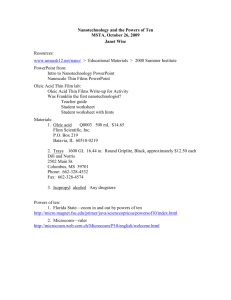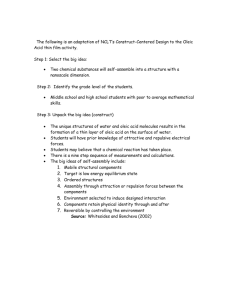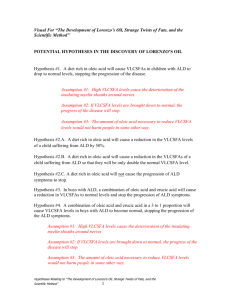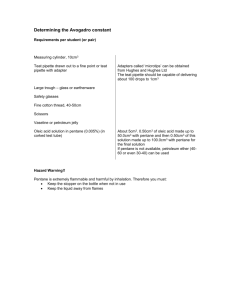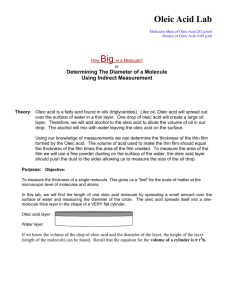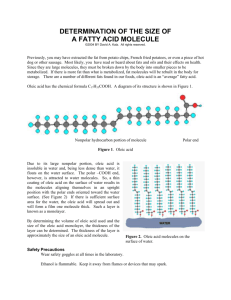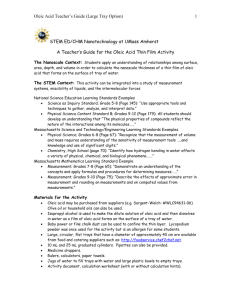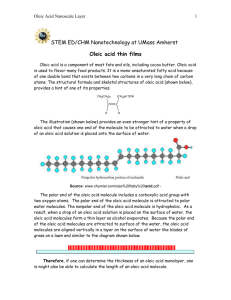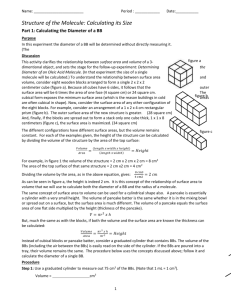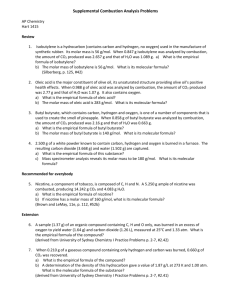Oleic acid thin films Oleic acid is a component of most fats and oils
advertisement
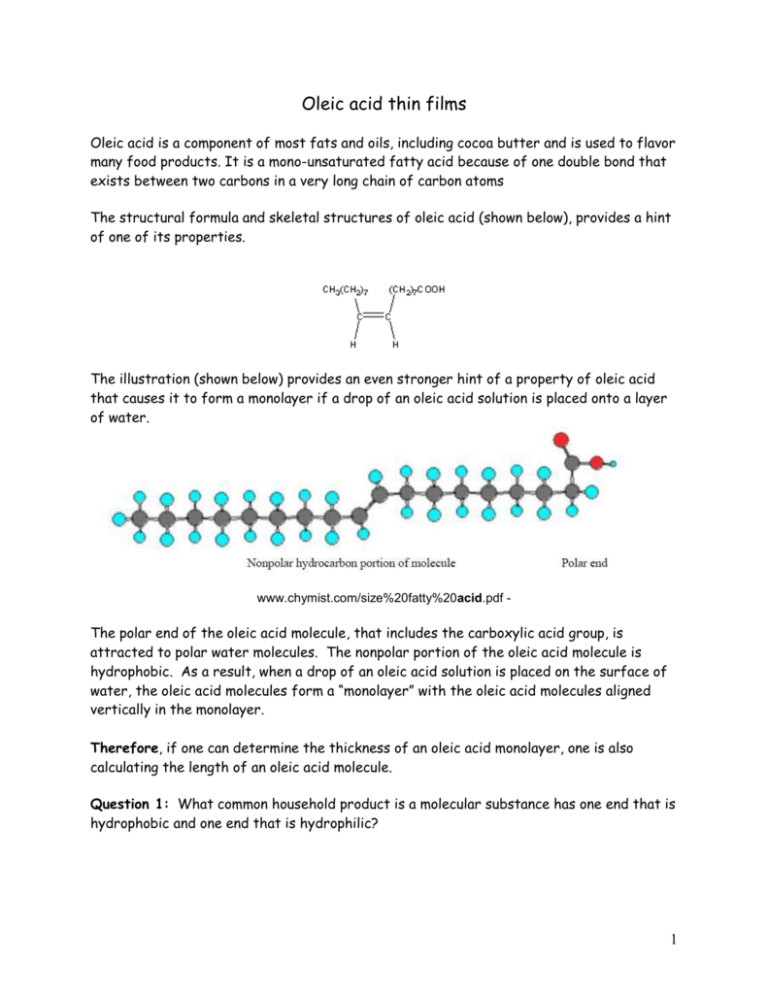
Oleic acid thin films Oleic acid is a component of most fats and oils, including cocoa butter and is used to flavor many food products. It is a mono-unsaturated fatty acid because of one double bond that exists between two carbons in a very long chain of carbon atoms The structural formula and skeletal structures of oleic acid (shown below), provides a hint of one of its properties. The illustration (shown below) provides an even stronger hint of a property of oleic acid that causes it to form a monolayer if a drop of an oleic acid solution is placed onto a layer of water. www.chymist.com/size%20fatty%20acid.pdf - The polar end of the oleic acid molecule, that includes the carboxylic acid group, is attracted to polar water molecules. The nonpolar portion of the oleic acid molecule is hydrophobic. As a result, when a drop of an oleic acid solution is placed on the surface of water, the oleic acid molecules form a “monolayer” with the oleic acid molecules aligned vertically in the monolayer. Therefore, if one can determine the thickness of an oleic acid monolayer, one is also calculating the length of an oleic acid molecule. Question 1: What common household product is a molecular substance has one end that is hydrophobic and one end that is hydrophilic? 1 The Procedure Read the entire procedure before starting Getting Started Create a work space large enough for a food tray, 2 graduated cylinders, paper towels, paper cups, dropper, pipet, ruler, and a calculator. Place enough water in a food tray to form a layer of water with a depth of approximately half a centimeter. A watering can will be provided. Each group will be given a small amount of oleic acid in a paper cup, Bottles of ethanol will be available to share among groups. Making a solution of oleic acid Put 1.0 mL of oleic acid into the 100 mL graduation cylinder. One option is to use a plastic pipet obtain the 1.0 mL sample of oleic acid. The other option is to use the 10 mL graduated cylinder to measure 1.0 mL of oleic acid. Add ethanol to the oleic acid in the 100 mL graduated cylinder until the total volume of the solution is 25 mL. Transfer the solution back and forth between a clean paper cup and the 100 mL graduated cylinder to thoroughly mix the solution. Put 1.0 mL of the oleic acid solution into the 100 mL graduated cylinder. Once again, add ethanol to the oleic acid in the 100 mL graduated cylinder until the total volume of the second solution is 25 mL. Again, transfer the solution back and forth between a clean paper cup and the 100 mL graduated cylinder to thoroughly mix the solution. Use the dropper and the 10 mL graduated cylinder to determine how many drops (N) of the second solution of oleic acid is contained in 1.0 mL of that solution. Making an oleic acid thin film Use the chalk eraser to sprinkle chalk dust onto the surface of the water in the food tray. Use the dropper to drop one drop of the second oleic acid solution onto the surface of the water in the food tray. Allow a short time for the alcohol solvent to evaporate into the air and dissolve in the water. Use the ruler to estimate the average diameter (in centimeters) of the circular layer of oleic acid. Returning materials when finished: Large plastic salad bowls will be provided to empty the food trays. Please return materials to a table at the front of the room (This write-up is adapted from http://www.sargentwelch.com/pdf/opinstr/72701-81.pdf) 2 Calculate the Depth (thickness) of the Monolayer You started with 1.0 mL of oleic acid which you diluted with enough ethanol to make 25.0 mL of a solution. You then diluted 1.0 mL of that first solution with enough ethanol to make 25.0 mL of a second solution. Question 2: How many mL of oleic acid would be in 1.0 mL of that second solution? You then determined how many drops (N) of the second oleic acid solution were contained in 1.0 mL of that solution. Question 3: What would be a formula for the volume of oleic acid in each drop of the solution? Question 4: What formula would you use to calculate the area of the oleic acid monolayer? Question 5 What formula would you use to calculate the depth (thickness) of the monolayer of oleic acid? Question 6: What will be the unit for the depth of your monolayer? Question 7: What is the depth of your monolayer (in centimeters and in meters)? Question 8: What are some sources of experimental error in the procedure you followed? Question 9: How could experimental error be reduced? Answers: Question 1 : Soap Question 2: Volume = 0.0016 mL Question 3: Volume = 0.0016 mL / N Question 4: Area = 3.14 x R2 Question 5: Depth = Volume / Area Question 6: Centimeters Question 7: answers will vary Question 8: answers will vary Question 9: answers will vary Note: Oleic acid may be purchased from Sargent-Welch; catalog # WLC94631-06; $14.60 per half liter. 800-727-4368. http://www.sargentwelch.com/ 3 4
